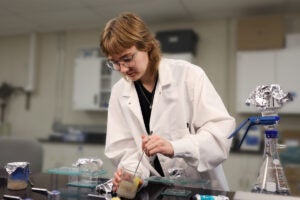AUSTIN, Texas —Astronomers from The University of Texas at Austin’s McDonald Observatory and other members of an international planetary research team have discovered a new planet in a solar system only 10.5 light years away from Earth. The planet, composed of gas, is orbiting a star called Epsilon Eridani, the fifth-brightest star in the constellation Eridanus.
Dr. William D. Cochran, a research scientist with McDonald and UT Austin’s department of astronomy, will present the planetary search team’s findings at a symposium on “Planetary Systems in the Universe,” as part of the 24th General Assembly of the International Astronomical Union in Manchester, England Aug. 7-18. The planetary symposium is scheduled for Aug. 7-10.
About 50 new planets, including this one, have been discovered in recent years. The UT Austin program has made three of these discoveries.
“Detecting a planet orbiting Epsilon Eridani — a star very similar to our own Sun and only 3.22 parsecs from Earth — is like finding a planet in our own backyard, relatively speaking,” said Cochran. “Not only is this planet nearby, it lies 478 million kilometers (or 297 million miles) from its central star — roughly the distance from the Sun to the asteroid belt in our own solar system.”
McDonald research scientists on the team included Cochran, Dr. Artie P. Hatzes and Barbara McArthur. They worked with Dr. Gordon Walker, University of British Columbia; Dr. Alan Irwin, University of Victoria; Dr. Sallie Baliunas, Harvard¬Smithsonian Center for Astrophysics; Dr. Martin Kªrster and Dr. Michel Endl, European Southern Observatory; Dr. Geoffrey Marcy, University of California, Berkeley; Dr. Paul Butler, Carnegie Institution of Washington; Dr. Stephenson Yang, University of Victoria; and Sebastian Els, European Southern Observatory Group.
The team’s research was based on a combination of six independent data sets taken with four different telescopes and with three different measurement techniques. Observations were made with the 2.7-meter (107-inch) Harlan Smith Telescope at McDonald Observatory, a UT Austin research facility located 16 miles north of Fort Davis.
Cochran and Hatzes drew from data collected by three other planet search groups, including the Canada¬France¬Hawaii Observatory on Mauna Kea, Hawaii, the Lick Observatory in Santa Cruz, Calif., and the European Southern Observatory in La Serena, Chile.
The new-found planet’s mass is estimated somewhere between 0.8 times the mass of Jupiter and 1.6 times the mass of Jupiter, Cochran said. Its orbit lasts just under seven years — about 60 percent the orbital period of Jupiter, but longer than that of most other recently discovered planets.
Astronomers are excited about the new planet’s rough similarity to Jupiter because astrobiologists believe Jupiter played an important role in the development of life on Earth. The largest planet in the Solar System and the fifth planet from the Sun, Jupiter is a massive ball of gas. It exerts such a strong gravitational pull that it is believed to serve as a protective barrier, generally preventing asteroids and meteorites from crashing down on Earth.
“The exciting thing about this discovery is that having a large planet orbiting fairly far out from Epsilon Eridani means there could be room for earth-like planets in a reasonably stable orbit closer into the star,” Cochran said. “All the planets found so far that are the size of Jupiter are much closer to the parent star. It means there could be room for an earth-like planet closer to Epsilon Eridani and — perhaps — in a habitable zone.”
In contrast to Jupiter, however, Cochran said this particular planet’s orbit is highly eccentric and elliptical. The orbits of Earth and its eight immediate neighbors are more circular. Stable orbits also are considered of crucial importance in the development of life.
Still, Cochran said, the discovery of the new planet circling Epsilon Eridani raises tantalizing possibility of detecting planets with longer orbital periods and of detecting multi-planet systems like the Solar System.
Epsilon Eridani is located in one of the 10 nearest star systems and is bright enough to be seen with the naked eye. “You can go outside at night, even in Austin, and point at it and say that star there has a planet around it,” Cochran said.
The planet has not been named because at present there is no accepted agreement on naming planets. Cochran said this is one of the issues that will be decided at the convention.
For more information, contact Gary Harrison, editor of Star Date Magazine at (512) 471-5285, or Dr. Jacquelin Mitton, Royal Astronomy Society Press Officer, telephone +44 1223 564 914, or
Mobile phone 07 770 386 133, or e-mail: jmitton@dial.pipex.com For the 24th General Assembly of the International Astronomical Union press room Aug. 7¬16, call +44 (0) 161 275 7832 or +44 (0) 161 275 9458 or +44 (0) 161 275 9499. Cochran’s Web page address is: www.as.utexas.edu/astronomy/people/cochran_w/cochran_w.html



